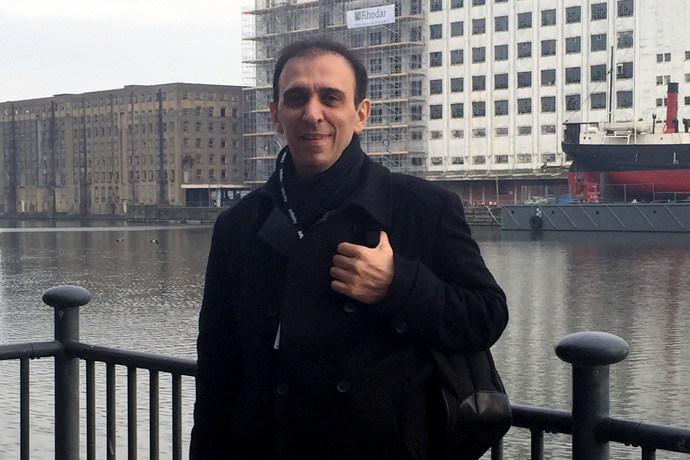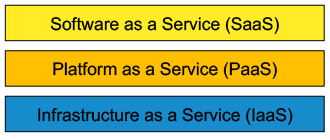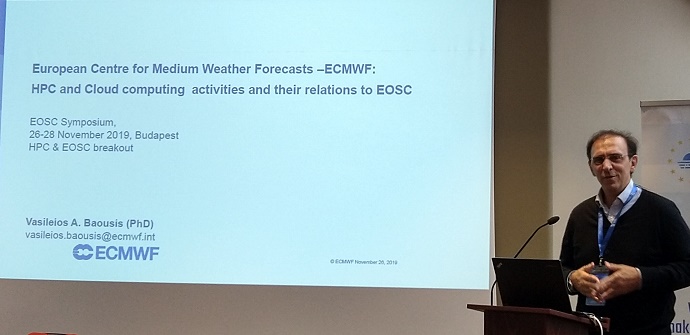

Vasileios Baousis has had a key role in developing the European Weather Cloud.
ECMWF will hold a virtual workshop on ‘Weather and climate in the cloud’ from 8 to 10 February 2021. One of the cloud projects covered in it will be the European Weather Cloud. Vasileios Baousis was one of the key players to prepare this joint computing infrastructure with EUMETSAT.
Vasileios has trained in both weather forecasting and computing. He completed a BSc at the Hellenic Air Force Academy before becoming an operational weather forecaster at the Hellenic National Meteorological Service.
He was awarded two Master of Sciences in communication systems and data networks in Britain and Greece, followed by a PhD in ‘Mobile and distributed computing’ at the University of Athens.
Vasileios started at ECMWF in 2010 as a network application programmer. For the last few years, he has been part of the team leading the design, development and evolution of the European Weather Cloud infrastructure at ECMWF.
His involvement has ranged from the hardware specification, deployment and configuration to deploying the cloud infrastructure, storage and orchestration.
The European Weather Cloud is currently in its pre-operational phase and a decision to make it operational is expected to be taken towards the end of 2021.
The goal of the European Weather Cloud
One of ECMWF’s objectives is to make the results of research and operations available to its Member States in the most appropriate form.
Today, as the volume of data produced at ECMWF continues to grow, processing close to the data is often the only way to handle them. Member and Co-operating States have always had the possibility to work with the data on managed Linux clusters or the high-performance computing facility (HPCF) itself, but cloud technologies offer new possibilities to meet this objective.
Member and Co-operating State users can directly host their application close to the data and benefit from the flexibilities cloud technologies offer. The first use cases during the pilot have shown that more data can be accessed fast with software solutions which Member and Co-operating States would not have been able to port onto ECMWF machines.
“The European Weather Cloud is a community cloud where ECMWF, EUMETSAT and Member and Co-operating States provide processing capabilities close to big data,” Vasileios says.

Cloud service models are traditionally split into three categories. The European Weather Cloud currently gives users access to computing resources and therefore primarily provides Infrastructure as a Service. Work is under way to also provide a Platform as a Service, where application and platform building blocks tailored for the meteorological community will be readily available. The long-term aim is to also offer a Software as a Service model.
That means that users from national meteorological services (NMSs) and from the European Meteorological Infrastructure (EMI) will be able to create applications using building blocks to be found on the European Weather Cloud.
“User support is key for the uptake of these technologies,” says Vasileios, “and both ECMWF and EUMETSAT pay great attention to it.”
Key characteristics
The European Weather Cloud pilot infrastructure was built entirely using open source software.
“We used the open source version of OpenStack for the cloud infrastructure and Ceph for the storage infrastructure,” Vasileios says.
“Procuring and installing the necessary hardware ourselves was a considerable undertaking considering the complexity of the software and the available time and resources.”
The result is a facility geared towards the meteorological community which is easy to use by basic to advanced cloud users.
It provides access to all ECMWF data archives with LAN speed and can facilitate machine learning workloads. In addition, it holds content from EUMETSAT and Member and Co-operating States.
The European Weather Cloud will be made up of different entities held together by a federation layer. Users can interact with different entities. By interacting with one, they can also access the others. Their European Weather Cloud activities are logged centrally in the federation layer. (ECMWF Newsletter No. 165, 2020)
“The success of the European Weather project so far can mainly be attributed to the considerable contribution of ECMWF and EUMETSAT Member and Co-operating States,” Vasileios says.
“They have been supporting the project from the beginning with their enthusiastic response and the definition of very interesting meteorological use cases. Member and Co-operating States also provided essential help in defining the security guidelines for the cloud infrastructure.”
Problems overcome
The European Weather Cloud was introduced while ECMWF was focusing on the migration of its data centre to Bologna, Italy.
“Staff had to be upskilled fast to operate the new technologies,” Vasileios says. He notes that there were considerable training needs for OpenStack, Ceph, user interface deployment, administration and support.
Tight security also had to be achieved since any breach would have had a substantial impact on the project.
“Security has been our primary design principle for ECMWF since the beginning,” he says. “We are constantly being vigilant by monitoring our infrastructure to keep the cloud safe and secure.”

Communicating ECMWF’s activities on cloud computing is part of Vasileios’ job, as here at the 2019 European Open Science Cloud (EOSC) Symposium.
Outlook
Vasileios keeps up with the evolution of cloud computing. “We plan to participate in Horizon 2020 research projects on cloud technologies so that we can contribute to the evolution of cloud computing,” he says.
In addition, ECMWF aims to provide feedback and source code to open-source communities like OpenStack and Ceph.
ECMWF also intends to use some of the experience gained in the European Commission’s Destination Earth (DestinE) programme, which aims to develop a high-precision digital model of the Earth. In DestinE, too, cloud computing is a core design principle.
“Cloud computing is really taking off in meteorology and more broadly Earth system science,” Vasileios says. “The European Weather Cloud has provided us with expertise which will be useful in other projects too.”
